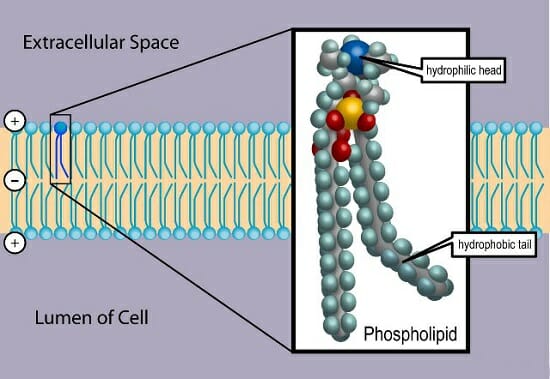3 Which Best Describes the Structure of a Phospholipid
This unique structure within the plasma membrane allows small substances like oxygen or carbon dioxide to easily pass through. The phospholipid is composed of a glycerol molecule and tow fatty acid chains.
How Can The Structure Of A Phospholipid Molecule Be Described Quora
Weve got the study and writing resources you need for your.
. This phospholipid contains hexahydric alcohol called inositol in its phosphorylated component. Structure of a Phospholipid Molecule. Fishelsoni is one of the largest bacteria known and it also happens to have a.
These groups are polar and are attracted to water. Start your trial now. Each phospholipid is amphipathic with two hydrophobic tails and a hydrophilic head.
A phospholipid is a lipid that contains a phosphate group and is a major component of cell membranes. Best Answer Copy A phospholipid is made up of a hydrophobic water-avoiding tail and a hydrophilic water-liking head. A phosphate group a glycerol connection and fatty acid chains.
The smaller the cell _______. A head and a tail. Phospholipids consist of a glycerol molecule two fatty acids and a phosphate group that is modified by an alcohol.
Some species use three fatty acid chains but two is most common. Each question has a helpful note written by an examiner. In this video were going to actually explore in detail the structure of phospholipids in our cell membrane.
The phospholipid molecules forms micelles when placed in water. The phosphorylated component contains ethanolamine here. All cells are surrounded by the cell membranes and this characteristic best portrayed by the Fluid Mosaic ModelAccording to this model which was postulated by Singer and Nicolson during the 1970s plasma membranes are composed of lipids proteins and carbohydrates that are arranged in a mosaic-like manner.
The fatty acid chains are the uncharged nonpolar tails which are hydrophobic. A single phospholipid molecule has two different ends. The tail end is made up of two strings of hydrogen and carbon atoms called fatty acid chains.
In an electron micrograph of a freeze-fractured membrane the bumps seen on the fractured surface of the membrane are. Solution for Describe the structure of a phospholipid and explain which regions of the phospholipid are hydrophobic and which are hydrophilic. And all of this is held together by glycerol backbone.
The head of the phospholipid containing the phosphate group and glycerols has a lot of electrophilic molecules like oxygen and phosphorous which makes that area relatively polar. Other substances such as water are able to pass through as well. The fatty acid chains are uncharged and non-polar while the phosphate head is polar and negatively charged.
These structures are often seen in nature as cell and organelle membranes. They are self-marking questions so you can click on check to see whether you have the answer correct. A lipid molecule with a polar head and a tail Phospholipid and is a class of lipids.
A single phospholipid molecule has a phosphate group on one end called the head and two side-by-side chains of fatty acids that make up the lipid tails. A phospholipid consists of a hydrophilic water-loving head and hydrophobic water-fearing tail see figure below. The hydrophilic head consists of a glycerol molecule bound to a phosphate group.
When phospholipids are added to an aqueous environment consisting mostly of water the phospholipid molecules will spontaneously assemble into a phospholipid bilayer where the layers are held together by weak attractive forces between molecules. Which of the following best described the make-up of a phospholipid. Phospholipids make up the basic structure of a cell membrane.
A phospholipid is a long biochemical structure made of three basic parts. Answer choices The head is polarhydrophilic. Tap card to see definition.
The phospholipid is essentially a triglyceride in which a fatty acid has been replaced by a phosphate group of some sort. When a membrane is freeze-fractured the bilayer splits down the middle between the two layers of phospholipids. A phospholipid is an amphipathic molecule which means it has both a hydrophobic and a hydrophilic component.
To maintain cell structure. This phospholipid has nitrogen containing choline in its phosphorylated component. The OH group in C1 is esterified with a saturated Fatty acid the OH group.
The head end contains a phosphate group and is hydrophilic. It has that polar phosphate head group and it has two fatty acid chains. Quizzes tests revision.
The head and the tail. The tail is non-polarhydrophobic. The phosphate group is the negatively-charged polar head which is hydrophilic.
This means that it likes or is attracted to water molecules. Surrounding cells in the membrane. In most bacterial cells the cell ______ is the structural sugar bound with protein layer surrounding the cell external to the plasma membrane.
First week only 499. A phospholipid consists of two basic parts. Membrane quiz 13.
Phosphate group heads with two fatty acid tails. It is the main part of cell membranes. The phospholipid is an amphiphatic molecule having hydrophobic tail and hydrophilic head.
Just to briefly remind us our phospholipid is often drawn like this. The hydrophobic tails face inward towards one another and the hydrophilic heads face outwards. Subunits of the phospholipid bilayer.
The second group the hydrophobic tail consists of two fatty acid chains. Click card to see definition. This is a quiz of multiple choice style questions about the structure of membranes topic 13.

Phospholipids Biology For Majors I

Phospholipid Definition Structure Function Biology Dictionary

0 Response to "3 Which Best Describes the Structure of a Phospholipid"
Post a Comment